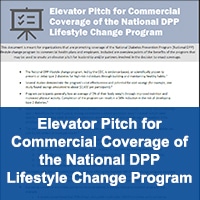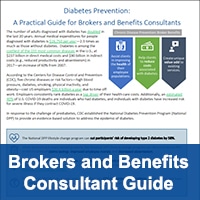Commercial Payers → Commercial and Employer Coverage → Coverage in Practice
Coverage in Practice
Commercial payers consist of commercial health plans (commercial plans) and employers (including state and local public employee coverage). This page describes how coverage for the National Diabetes Prevention Program (National DPP) lifestyle change program typically functions for commercial payers in real-world settings. It also provides examples of organizations that are currently covering the National DPP lifestyle change program and some suggested best practices. Click on a link below to go directly to that section.
- Why Employers Cover the National DPP Lifestyle Change Program
- About Employer Health Insurance
- Examples of Employers and Commercial Plans Covering the Program
- Covering the Program: A Consultant Perspective and Broker Tools
Why Employers Cover the National DPP Lifestyle Change Program
Employers across the nation are making the decision to cover the National DPP lifestyle change program for various reasons, including the fact that it can:
- Decrease the cost of providing health care to employees over time;
- Improve the health of at-risk employees by preventing or delaying the onset of type 2 diabetes;
- Engage employees in preventive care practices, resulting in higher productivity; and
- Provide a wellness benefit for employee retention.
Employers have also cited additional benefits from offering the National DPP lifestyle change program, including positive behavioral health modifications, a focus on population health improvement, increasing employee engagement, and increasing employee satisfaction. Employee health can improve through reducing blood pressure, cholesterol levels, and weight, and increasing sleep quality by decreasing sleep apnea (see Evidence). For more information about why Employers may choose to cover the program, see the Case for Coverage for Commercial Plans and Employers page and the Cost and Value page.
Additionally, see the Elevator Pitch for Commercial Coverage of the National DPP Lifestyle Change Program document for talking points that may be used when approaching leadership and/or partners involved in the decision to enact coverage.
Employers: Sign up for NACDD’s Employer Network to connect with other benefits and wellness professionals who have adopted the National DPP lifestyle change program as a covered benefit for their employees, and stay aware of new resources and tools to make your diabetes prevention work easier.
About Employer Health Insurance
Employers can provide health insurance coverage for their employees through a variety of methods, but for the purposes of this toolkit, we distinguish between employers with a (1) fully-insured health plan; and those with a (2) self-funded health plan.
- Employers with a fully-insured health plan pay an insurance company to assume financial risk for their employees; i.e., the employees’ health care claims are paid by the insurance company.
- Employers with a self-funded health plan accept financial risk and administer their own health insurance plan; i.e., the employees’ health care claims are paid by the employer.
This distinction of fully insured vs. self-insured is important, because the decision to offer the National DPP lifestyle change program and how it is delivered may vary depending on the employers’ method of insurance coverage. According to an analysis of the Census Bureau’s American Community Survey (ACS) data in 2018, 49% of individuals in the United States had health insurance through their employer, and a 2018 Employer Health Benefits Survey found that 61% of covered employees were in a health plan that was completely or partially self-funded.
- Employers with a fully-insured health plan work with a fully-insured health plan vendor (often with assistance from a broker or benefit consultant) to decide whether to cover the program for their employees or a subset of their employees. Employers with a fully-insured health plan do not have the same financial motivations as employers with a self-funded plan, since those in a fully-insured plan have shifted the financial risk associated with the management of the plan, including care management and wellness programs, to the fully-insured health plan vendor.
- Employers with a self-funded health plan decide themselves (often with assistance from a broker or benefit consultant) whether to cover the National DPP lifestyle change program for their employees or a subset of their employees. Because the employer is on the front line for managing health plan expenses, they are highly motivated to implement changes that will contain health care costs and are likely to be more receptive to offering the National DPP lifestyle change program. Typically, the program is most appealing to employers with a self-funded health plan who have at least 750 employees.
For more information regarding employers with self-funded health plans, see the “The Unique Positioning of Employers with a Self-Funded Health Plan” section on the Case for Coverage for Commercial Plans and Employers page.
Covering the Program
Employers can organize and administer the National DPP lifestyle change program in multiple ways. It can be provided as a health benefit under the insurance plan; or many employers provide a wellness program for their employees that is designed to help employees eat better, improve fitness, lose weight, or simply improve overall health. The National DPP lifestyle change program shares these common goals and is an evidence-based program that has proven effective for employees at risk for type 2 diabetes. It would be an effective addition to an employer’s wellness program.
Various options for program delivery, coverage method, contracting parties, and contract type can be combined to create a program structure that best fits the employer organization and its employees. Many of the options that make up the program framework can be seen in the table below.
*Regardless of the delivery method—onsite, online, or in the community—the organization should be recognized by the CDC’s Diabetes Prevention Recognition Program (DPRP). For more information about the DPRP, please see Implementing a Lifestyle Change Program and Standards for CDC Recognition.
Note: An employer should never store individual employee information in the same location as employee health information. Many challenges with health information privacy can be eliminated by contracting with a health organization to provide screenings or by holding health-related classes off-site. Employers may not discriminate against an employee based on genetic information, including risk of diabetes.
Employer Resources from the AMA
To offer or implement the National DPP lifestyle change program, the American Medical Association (AMA) has created resources that may be useful to employers. For more information, or to request the full employer toolkit, please contact the AMA directly at iho@ama-assn.org.
Using HSA Dollars to Pay for the Program
Guidance provided by the Internal Revenue Service (IRS) in Publication 502 suggests that under certain circumstances individuals may be able to use funds in their Health Savings Accounts (HSA) to cover the costs of participating in the National DPP lifestyle change program. According to the IRS’ guidance, individuals would need to be diagnosed by a physician with a disease such as obesity, hypertension, or heart disease to use funds in their HSA account.
The IRS stipulates the following:
You can include in medical expenses amounts you pay to lose weight if it is a treatment for a specific disease diagnosed by a physician (such as obesity, hypertension, or heart disease). This includes fees you pay for membership in a weight reduction group as well as fees for attendance at periodic meetings. You can’t include membership dues in a gym, health club, or spa as medical expenses, but you can include separate fees charged there for weight loss activities.
Note: Individuals should consult with an HSA or tax expert to ensure any expenditure of HSA funds complies with IRS guidance.
Examples of Employers and Commercial Plans Covering the Program
Below is a description of several employers and one commercial plan that have chosen to cover the National DPP lifestyle change program for their employees and beneficiaries. For a larger list of employers and commercial plans currently covering the program, visit the Participating Payers page of the Coverage Toolkit.
Multi-Employer Comparisons
“National DPP Case in Point” provides a comparison of how three employers, Dow Chemical, Latham & Watkins, and the University of Michigan, made the decision to cover the National DPP lifestyle change program. It includes a description of the program structure, provider selection and course delivery, population targeting and promotion, and lessons learned for each organization. For more information, or to request the full employer toolkit, please contact the AMA directly at iho@ama-assn.org.
“Implementing the National Diabetes Prevention Program” contains case studies of how six organizations in the New York Metropolitan and Greater Philadelphia regions have promoted coverage of the National DPP lifestyle change program. The organizations highlighted are Latham & Watkins, New York City Mayor’s Office of Labor Relations, Healthfirst, Greater Philadelphia Business Coalition on Health, VWR, and Christiana Care Health System.
AJMC Podcast
The American Journal of Managed Care produced a podcast featuring Jill Hutt from the Greater Philadelphia Business Coalition on Health (GPBCH). The podcast describes how the GPBCH has supported employers to implement coverage of the National DPP lifestyle change program, including convening an obesity and diabetes prevention and management employer collaborative, and engaging employer members in conducting pilots to offer the National DPP lifestyle change program. It also describes the successful implementation of the National DPP lifestyle change program in the City of Wilmington in Delaware.
Costco
Costco started offering the program as a pilot, rolling it out nationwide after finding that employee engagement and retention rates in the program were high. As of May 2016, about 10,000 Costco employees have participated in online delivery of the program. The program is a covered medical benefit for employees and spouses. Costco encouraged initial participation by conducting a regional competition to complete a “One-Minute Challenge,” a computer-based tool meant to identify potentially eligible individuals. At some sites, 50‒60% of employees participated in this challenge.
Florida Blue
Florida Blue is the largest commercial health plan in Florida, providing insurance to individuals under 65, Medicare Advantage plans, and commercial group plans. It began offering the National DPP lifestyle change program to its employees in 2013 and expanded the program to Florida Blue members statewide in 2014.
As of December 2016, the National DPP lifestyle change program was available to 20 employer groups. 1,055 people had attended at least one session, of which 805 (76%) attended at least four sessions and 545 (52%) attended at least nine sessions. 107 (31%) of these participants had achieved the weight loss goal of 5% or more.
In 2017, Florida Blue began offering the program to Medicare Advantage beneficiaries, and as a wellness program for fully-insured commercial group members.
Florida Blue has promoted awareness and access to the National DPP lifestyle change program in a variety of ways, including:
- Providing statewide access to its in-person diabetes prevention classes through its provider- and Care Consultant-staffed community-based retail centers.
- Engaging with physicians and facilitating referrals in Patient Centered Medical Homes (PCMHs). To improve flexibility in participation, Florida Blue has allowed referred individuals in PCMHs to partake in lifestyle change classes at a physician practice or a YMCA.
- Forging partnerships with Solera Health and the YMCA of the USA to expand choice and minimize barriers to participation. With these partners, the program has been offered online, as well as in-person at numerous locations throughout the state, including employer worksites.
More information about Florida Blue’s coverage of the National DPP lifestyle change program can be found here.
Iron Mountain, Inc.
This study describes the outcomes of online delivery of the National DPP lifestyle change program to employees of Iron Mountain, Inc., a global storage and information management services company that employs 25,000 people worldwide, with 8,800 employees in the United States spread across 44 states. The study had a non-randomized design with a matched control group. Overall, employees were gaining an average of 3.5 pounds annually before program inception. 83% of participants in online delivery of the National DPP lifestyle change program completed most of the curriculum and 31% lost at least 5% of their starting weight. When compared with non-participating peers, participants demonstrated reduced weight, improved fasting blood glucose, and improved nutritional intake after a year.
Minnesota Health Action Group
The Minnesota Health Action Group convened employers and other stakeholders to improve the value of health and health care. It shared some of the experiences of its partner employers that have implemented the National DPP lifestyle change program. These experiences highlight important considerations for employers deciding how to implement the program.
Employee demand – If a small employer, are there enough employees to fill an onsite class? Other available options, in addition to onsite classes, include offering an online program, combining with a community class, or partnering with another local employer.
Online experience – Are employees comfortable using technology and able to go online to check in? Can the employees access the program at work on company time?
Team-learning approach – Do employees prefer face-to-face learning? Is it likely that a more personalized, group experience will be successful? Is the program available through community classes from a local hospital, YMCA, or extension program?
Payment options – Employers may request to have the National DPP lifestyle change program covered by health insurance benefits. If it is not a covered benefit, other options for financing include using discretionary dollars, training budgets, or other means to pay for the program. Some employers may ask the employee to pay a portion of the fee, which can enhance personal accountability and the likelihood of successful program completion.
North American Employer
One employer offers the National DPP lifestyle change program across campuses in North America and has enrolled over 2,400 individuals. It offers an onsite program at four locations and online, and community-partner programs at many more. Results have been positive, with almost 40% of Canadian participants achieving at least 5% weight loss. (Weight loss statistics for the U.S. population were not available).
University of Chicago Medicine
The University of Chicago Medicine (UChicago Medicine) is a nonprofit, academic and community health system based on the campus of the University of Chicago that provides patient care, research, and medical education. With 9,400 employees, self-insured UChicago Medicine is one of Illinois’s largest employers. The Midwest Business Group on Health, a health benefits influencer and partner, introduced UChicago Medicine to the benefits of the National Diabetes Prevention Program (National DPP) lifestyle change program.
UChicago Medicine began offering the National DPP lifestyle change program as a pilot in July 2020 to more than 5,000 employees, their spouses, and their adult dependents. The pilot resulted in a 93% satisfaction rating among its 288 participants who lost more than 1,700 total pounds combined. Success has led to planned expansion to its exclusive provider organization plans as well beginning Fall 2021. Read more about UChicago Medicine’s coverage of the National DPP lifestyle change program, including insider tips and participant incentives, here.
University of Colorado
With over 20,000 employees, the University of Colorado (CU) is one of Colorado’s largest employers. CU employees serve in various roles from administration, instruction, research, facilities management, and security. The employees represent a wide range of health conditions and in 2014 CU decided it was time to engage employees with a preventative approach. The Colorado Department for Public Health and Environment (CDPHE) introduced CU to the National DPP lifestyle change program. CU Health Plan staff were trained on the program to increase their understanding of the member experience.
To date, CU has offered the National DPP lifestyle change program to 2,110 members, with an average retention rate of 81% and weight loss average of 6.73 lbs., resulting in an estimated health care savings of over $16 million annually. Read more about their story here.
State and Local Public Employee Coverage
One sector of employers that have implemented the National DPP lifestyle change program successfully are state employee health plans. States that offer the program are able to reach a large number of members, increasing their options for how to deliver the program. State employee health plans are especially well suited to implement the National DPP lifestyle change program due to the longevity and stability of their beneficiary population if they carry their beneficiaries through retirement. A list of states with state-public employee coverage of the National DPP lifestyle change program can be found on the Participating Payers page of the Coverage Toolkit.
California
California’s Public Employees’ Retirement System (CalPERS) began implementing the program for all CalPERS members, through all contracted health plans, as of January 2017.
City of Wilmington
The City of Wilmington, Delaware, is a self-injured employer with an employee base of more than 1,100 employees working in diverse roles across administration, fire, police, water, local health department, and city operations. Building on an existing culture of health and history of investment in prevention, and with support from the Delaware Department of Health and Social Services, the City of Wilmington began offering the National Diabetes Prevention Program (National DPP) lifestyle change program in 2020 at no cost to its employees, their spouses, and their adult dependents. Read more about the City of Wilmington’s coverage of the National DPP lifestyle change program, including insider tips and participant feedback, here.
Additionally, the American Journal of Managed Care produced a podcast featuring Jill Hutt from the Greater Philadelphia Business Coalition on Health (GPBCH), that describes the successful implementation of the National DPP lifestyle change program in the City of Wilmington.
Kentucky
The Kentucky Employees’ Health Plan has implemented the National DPP lifestyle change program since 2014.
Minnesota
Minnesota began implementing the National DPP lifestyle change program as a covered benefit for all state employees and their adult dependents in April of 2015. The state chose an online program, allowing employees throughout the state, including those in more isolated, rural areas, to participate. The benefit involves a pay-for-performance, staggered claims process. An initial claim is made at the time of enrollment, followed by a second claim after an employee completes 9 weeks of the program and a final claim based on health outcomes. To learn more, about Minnesota’s approach to state employee coverage, see the document entitled, “Emerging Practices in Diabetes Prevention and Control.”
New York City
The New York City Department of Labor has offered the National DPP lifestyle change program since 2016. New York City has an 80% retention rate, and program participants have reported positive experiences and high levels of engagement. Current demand for the program exceeds supply, and adoption of the program has expanded to other city agencies. The Department of Labor has also leveraged partnerships with employee unions and a university to support data collection and analysis. Although the program is not a covered benefit, it is offered at no cost to employees on a first-come, first-served basis. The department is seeking to secure insurance coverage in the future for program expansion.
Washington
Washington State started offering the National DPP lifestyle change program to state employees in 2016. It identified eligible enrollees through worksite screening events where employees could enroll in the program (some sites allowed spouses to also enroll). Classes were held onsite and in the community when the number of eligible employees was not large enough to host an onsite class. The state saw positive outcomes; 40% of enrollees who completed the course also achieved at least 5% weight loss.
Washington has also begun offering online delivery of the program through Omada, an online CDC-recognized organization. Between January 2019 and February 2020, 2,970 employees joined the online delivery of the program and lost 23,298 pounds collectively.
To learn about a pilot that helped facilitate Washington state coverage of the National DPP lifestyle change program for state employees, see the document entitled, “Emerging Practices in Diabetes Prevention and Control.”
For an example of a collaborative effort around coverage of the National DPP lifestyle change program for state and local public and private employee coverage, watch the video below. This video was developed in partnership between the Delaware Department of Health and Social Services’ Division of Public Health and the Greater Philadelphia Business Coalition on Health to raise awareness and increase coverage of the National DPP lifestyle change program.
Covering the Program: A Consultant Perspective and Broker Tools
Consultant Perspective: Aon
A consultant from Aon, a leading global professional services firm, shared the following perspective about employers coverage of the National DPP lifestyle change program.
The Role of a Consultant in Supporting Employers Regarding the National DPP Lifestyle Change Program
- Consulting firms, like Aon, have teams that lead health and benefit consulting relationships with employers.
- The National DPP lifestyle change program was a “hot topic” for employers when it first became available, but interest has waned in recent years as treatment vendors are typically advertised more. As such, employers generally gravitate towards treating the problem. Part of the consultant’s role is to try to expand their focus to address the root of the issues by focusing on prevention and risk reduction as well.
- There is no one-size-fits-all approach and consultants tailor their feedback to each employer’s needs and budget constraints.
- When bringing a program like the National DPP lifestyle change program to the table for employers, they look at data, culture, needs, and cost-drivers to help the employers make the best decisions that integrate within their overall wellbeing strategy.
- A major barrier to employers implementing the National DPP lifestyle change program is that it must integrate with the organization’s overall wellbeing strategy and needs to differentiate itself from other weight-loss programs and solutions the organization may already be providing or considering. Employers manage a number of solutions and programs/vendors so each must have a clear purpose and integration strategy.
- “It’s imperative for employers to see an additional added value when considering adding a new vendor. Vendors that have multiple offerings may appeal more to employers.”
- When discussing programs like the National DPP lifestyle change program with employers, Aon does not talk about costs alone because, when investing in prevention, it could take time to see downstream improvements. They focus on the “value on investment (VOI)” as opposed to the “return on investment (ROI)”. Aon works with employers to develop a robust measurement framework to be able to measure the value and impact.
- The process used to decide to implement the program depends on each employer. Some employers have built the business case and are ready and willing to implement programs and tactics. In that case, the decision-making process could take around six months. For others who are still looking at the data and available solutions, it could take up to 18 months.
- Employers that are ready to act typically have data supporting the need for prevention, leadership that understands the data, a strong wellbeing strategy, and the budget to implement a new vendor.
- Employers may hesitate to add a new vendor that only offers one modality or program to address a small portion of their population. If an employer is looking for a smaller number of vendors, they may want a new vendor to impact multiple population health factors or a broader population. At a minimum, the integration with other programs, offerings, and comorbidities should be clear.
Employer Decision Points When Implementing the Program
- Employer preference for the delivery method of the National DPP lifestyle change program (in-person, distance learning, or online) often depends on their culture and workforce demographics and whether the organization is global, national, or local in reach.
- If the organization is local, employers may be more interested in in-person programming. Local, smaller employers may be less likely to have a larger budget for online delivery of the program.
- If the organization is national, it’s a challenge to coordinate in-person programs. Many employers are looking for the same benefit to be rolled out to all employees, regardless of location, which is why online or virtual delivery is preferred.
Increasing Employer Awareness
- Aon looks to impact health across prevention, risk reduction, and treatment. To increase employer awareness of the National DPP lifestyle change program, success stories from all different types and sizes of employers are important. Employers often want to see case studies from other employers to see their successes and learn from others.
Brokers and Benefits Consultants
For more information about how health insurance brokers and benefit consultants are uniquely positioned to promote the National DPP lifestyle change program among their employer client base, see the Diabetes Prevention: A Practical Guide for Brokers and Benefits Consultants document. This document explains why a broker or benefit consultant would want to promote the National DPP lifestyle change program and how to promote the program. For further information on how to talk to clients about the National DPP lifestyle change program, visit the CDC’s page for Insurance Brokers and Consultants. There you can find resources such as introductory email and script language, informational flyers for employers, and a customizable savings infographic.













